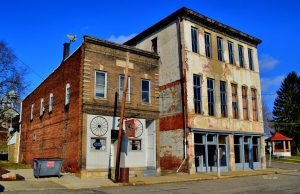Hundreds of unidentified coal mines burrow beneath the surface of Perry County, Ohio, and its surrounding communities, forming a skeleton of the region’s once-thriving economy. These towns, known as The Little Cities of Black Diamonds, once thrived; reliant on coal, miners, and the economic flow this industry supplied. However, since coal’s peak in Ohio during the 19th century, industrialization, technological advances, and shifting energy priorities have pushed the industry into decline, weakening the demand for coal.
Although coal mining remains an important industry in parts of Appalachia, employment levels in places like Perry County have rapidly declined due to mechanization and the reduced need for human labor. While automation made mining safer by reducing workers’ exposure to hazardous conditions, it also triggered widespread job loss, leading to economic hardship and population decline. Families who remained often faced generational poverty as opportunities dwindled.
When driving through small ‘patch towns’ in Perry County, the effects of this exodus are evident. Historical photographs from the 1800s and 1900s depict streets lined with buildings–many of which are now boarded up, empty, or nonexistent. Despite these changes, residents remain optimistic about their county and take pride in their rich history of supplying the Midwest with the coal that fueled industrialization.

Shawnee, Ohio Today
Shawnee, Ohio, settled within the Appalachian Coal belt of Southern Ohio, is often labeled a ‘ghost town.’ However, it stands as a resilient reminder of the deep cultural roots many residents share with their ancestors.
Community-led initiatives have begun restoring Shawnee’s historic downtown, highlighted by the Eclipse Company Town, a former public mining company that recently transitioned into a private historical society.
The Eclipse Company Town began restoring 12 historic houses in downtown Shawnee in 1997, completing the project in 2008. Today, the restored buildings serve as a restaurant, event space, and home to Rural Action, a nonprofit organization dedicated to community development in Appalachian Ohio.
These businesses and collectives thrive within the spaces occupied by the town’s predecessors–structures that previously housed miner’s pay stations, general stores, and workers’ homes. They serve as a physical metaphor for the community’s longevity and commitment to cultural preservation. The Eclipse Company Town is listed on the National Register of Historic Places and is an active member of the Little Cities of Black Diamonds Council, which celebrates the area’s rich heritage. This connection strengthens an effort to reclaim Appalachian history–shifting the narrative away from stereotypes of poverty and decline to one that recognizes the essential role miners played in fueling the industrialization of the Midwest.
Rural Action, founded in 1991, is focused on the sustainable advancement of southeastern Ohio communities by addressing food and agriculture, forest conservation, waste management, environmental education, watershed restoration, tourism, and economic development. While its work is most visible in 25 Ohio counties, its impact extends to 59 counties through stream restoration and social initiatives.
Founded out of a governmental need to protect watershed and water resources from acid mining runoff due to the hazards of surface mining, the collective expanded outside of water necessities after finding that the environmental hazards of the region are built and upheld by social oppressions, such as the lacking governmental aid for impoverished communities after the decline of industry. As a result, Rural Action became a membership-based organization, reflecting the Appalachian region’s cultural values and its history of resilience.
Over the past 32 years, Rural Action has helped fund and launch over thirteen social enterprises, including True Pigments, a collective that repurposes mining pollutants from streams into usable paint products; Rural Action continues funding projects for social, economic, and education development within the Appalachian region in Ohio.
For these communities, adaptation is more than survival–it is a testament to the enduring power of cultural identity and collective action. Their resilience preserves a legacy for future generations while forging a path toward a sustainable future.

